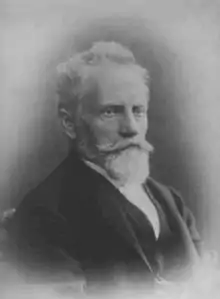
Hermann Dingler (23 May 1846 – 30 December 1935) was a German physician and botanist. He was a son-in-law of chemist Emil Erlenmeyer and the father of philosopher Hugo Dingler.
Dingler was born in Zweibrücken. He studied medicine at the universities of Zürich, Erlangen, Vienna and Munich, then participated in a botanical study trip to Palestine and Asia Minor. Afterwards, he spent a few years working as a military and railway physician in the Turkish service. In 1883 he obtained his habilitation at Munich, then from 1889 to 1910, he taught classes in botany at the Forestry University in Aschaffenburg.[1]
While an instructor at Aschaffenburg and afterwards, he conducted lengthy research trips to Asia Minor (1892), Ceylon (1909), Sicily (1912) and the Caucasus (1914). In 1907 he founded a district committee for nature conservation in western Lower Franconia — his main focus was towards the establishment of a reserve for oak trees in Spessart.[1] From 1906 onward, he published several works associated with the genus Rosa (roses).[2] He died in Aschaffenburg, aged 89.
Selected works
- Ueber das scheitelwachsthum des gymnospermenstammes, 1882.
- Die flachsprosse der phanerogamen, Vergleichend morphologisch-anatomische Studien, 1885.
- Die bewegung der pflanzlichen flugorgane; ein beitrag zur physiologie der passiven bewegungen im pflanzenreich, 1889.
- Ueber asymmetrie in der drüsenanordnung und rotfärbung bei den fiederblättchen mancher rosen, 1906.[3]
References
- 1 2 Dingler, Hermann In: Neue Deutsche Biographie (NDB). Band 3, Duncker & Humblot, Berlin 1957, ISBN 3-428-00184-2, S. 729.
- ↑ BHL Taxonomic literature : a selective guide to botanical publications and collections with dates, commentaries and types
- ↑ HathiTrust Digital Library published works
- ↑ International Plant Names Index. Dingler.